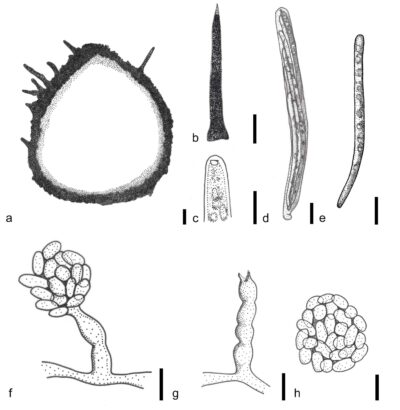Fungalpedia – Note 211, Ericiosphaeria
Ericiosphaeria Réblová & Hern. -Restr.
Citation when using this entry: Silva et al. 2024 (in prep). – Fungalpedia, Sordariomycetidae.
Index Fungorum; Facesoffungi, MycoBank, GenBank, Fig. 1
Classification: Chaetosphaeriaceae, Chaetosphaeriales, Sordariomycetidae, Sordariomycetes, Fungi.
Ericiosphaeria was introduced by Réblová & Hern.-Restr (2021) to accommodate E. spinosa (F.A. Fernández & Huhndorf) Réblová & Hern.-Restr as a new combination. This monospecific genus has been incorporated into the taxonomic classification of Sordariomycetidae, specifically in Chaetosphaeriales, within Chaetosphaeriaceae (Index Fungorum 2023). This is supported by molecular evidence derived from combined ITS-LSU sequence analysis, along with a morphological comparisons (Réblová & Hern.-Restr 2021). Ericiosphaeria is a saprobe that decays bark and wood, and currently reported only from North America (Fernández & Huhndorf 2005, Réblová & Hern.-Restr 2021). The asexual morph has a phialidic conidiogenesis. Setae are absent. Simple, solitary, and semi-macronematous conidiophores are observed. Conidiogenous cells are hyaline, monophialidic, and ampulliform, with funnel-shaped collarettes. Conidia accumulate in slimy fascicles, ellipsoidal to globose, aseptate, and hyaline (Fernández & Huhndorf 2005, Réblová & Hern.-Restr 2021). At the same time, it has superficial, non-stromatic, and perithecial ascomata, with an apillate and dark brown rigid setose, which is never conidiogenous. The ostiolar canal is periphysate. Fragile, carbonaceous, two-layered ascomatal wall. Paraphyses are branching, hyaline, and septate. Unitunicate asci are cylindrical clavates with eight spores. Ascospores are cylindrical to filiform, aseptate, and asymmetrical (Fernández & Huhndorf 2005, Réblová & Hern.-Restr 2021).
Although the type strain displays morphological similarity to Paragaeumannomyces in asci, ascospores, and setae, molecular analysis revealed that it clustered as a sister clade outside Paragaeumannomyces (Réblová & Hern.-Restr 2021). Morphologically, it can be distinguished by having minute, dark ascomata covered by short setae, two-layered ascomatal walls, scolecosporous, hyaline, and anamorphs with phialidic conidiogenesis (Réblová & Hern.-Restr 2021).
Type species: Ericiosphaeria spinosa (F.A. Fernández & Huhndorf) Réblová & Hern.-Restr.
Basionym: Chaetosphaeria spinosa F.A. Fernández & Huhndorf,
Figure 1 – Ericiosphaeria spinose. a = Longitudinal section through ascoma. b = Ascomal seta. c = Apical ring. d = Asci. e = Ascospore. f = Phialide with a cluster of conidia. g = Phialide. h = Conidia. Scale bars: a–h = 10 µm. Redrawn from Fernández & Huhndorf (2005).
References
Entry by
Veenavee Sulakkana H. Silva, Center of Excellence in Fungal Research, Mae Fah Luang University, Chiang Rai 57100, Thailand.
(Edited by Antonio Roberto Gomes de Farias, Samaneh Chaharmiri-Dokhaharani, & Achala R. Rathnayaka)
Published online 15 February 2024
